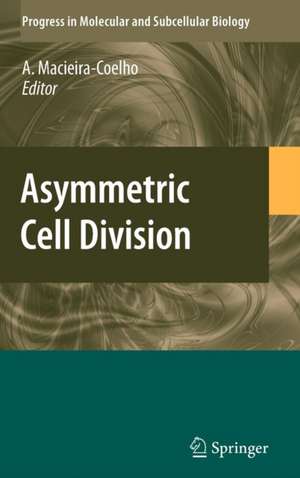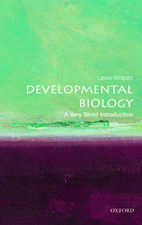Asymmetric Cell Division: Progress in Molecular and Subcellular Biology, cartea 45
Editat de Alvaro Macieira-Coelhoen Limba Engleză Hardback – 3 apr 2007
| Toate formatele și edițiile | Preț | Express |
|---|---|---|
| Paperback (1) | 1209.64 lei 6-8 săpt. | |
| Springer Berlin, Heidelberg – 22 noi 2010 | 1209.64 lei 6-8 săpt. | |
| Hardback (1) | 1221.69 lei 6-8 săpt. | |
| Springer Berlin, Heidelberg – 3 apr 2007 | 1221.69 lei 6-8 săpt. |
Din seria Progress in Molecular and Subcellular Biology
- 18%
 Preț: 1115.46 lei
Preț: 1115.46 lei - 18%
 Preț: 1403.04 lei
Preț: 1403.04 lei - 18%
 Preț: 1112.30 lei
Preț: 1112.30 lei - 18%
 Preț: 1117.03 lei
Preț: 1117.03 lei - 18%
 Preț: 1222.49 lei
Preț: 1222.49 lei - 18%
 Preț: 1382.21 lei
Preț: 1382.21 lei - 18%
 Preț: 1232.26 lei
Preț: 1232.26 lei - 18%
 Preț: 1222.80 lei
Preț: 1222.80 lei - 24%
 Preț: 1045.93 lei
Preț: 1045.93 lei - 18%
 Preț: 956.50 lei
Preț: 956.50 lei -
 Preț: 387.20 lei
Preț: 387.20 lei - 15%
 Preț: 639.73 lei
Preț: 639.73 lei - 15%
 Preț: 633.19 lei
Preț: 633.19 lei - 15%
 Preț: 634.18 lei
Preț: 634.18 lei - 15%
 Preț: 634.00 lei
Preț: 634.00 lei - 15%
 Preț: 640.24 lei
Preț: 640.24 lei - 5%
 Preț: 714.27 lei
Preț: 714.27 lei - 15%
 Preț: 634.32 lei
Preț: 634.32 lei - 15%
 Preț: 637.28 lei
Preț: 637.28 lei - 15%
 Preț: 637.78 lei
Preț: 637.78 lei - 15%
 Preț: 637.28 lei
Preț: 637.28 lei - 15%
 Preț: 649.06 lei
Preț: 649.06 lei -
 Preț: 387.75 lei
Preț: 387.75 lei - 18%
 Preț: 1220.75 lei
Preț: 1220.75 lei - 18%
 Preț: 1224.99 lei
Preț: 1224.99 lei - 18%
 Preț: 946.87 lei
Preț: 946.87 lei - 15%
 Preț: 633.35 lei
Preț: 633.35 lei - 18%
 Preț: 944.36 lei
Preț: 944.36 lei -
 Preț: 387.96 lei
Preț: 387.96 lei - 15%
 Preț: 633.02 lei
Preț: 633.02 lei - 15%
 Preț: 640.88 lei
Preț: 640.88 lei - 5%
 Preț: 720.10 lei
Preț: 720.10 lei
Preț: 1221.69 lei
Preț vechi: 1489.87 lei
-18% Nou
Puncte Express: 1833
Preț estimativ în valută:
233.80€ • 243.19$ • 193.02£
233.80€ • 243.19$ • 193.02£
Carte tipărită la comandă
Livrare economică 14-28 aprilie
Preluare comenzi: 021 569.72.76
Specificații
ISBN-13: 9783540691600
ISBN-10: 354069160X
Pagini: 275
Ilustrații: XII, 248 p.
Dimensiuni: 155 x 235 x 22 mm
Greutate: 0.56 kg
Ediția:2007
Editura: Springer Berlin, Heidelberg
Colecția Springer
Seria Progress in Molecular and Subcellular Biology
Locul publicării:Berlin, Heidelberg, Germany
ISBN-10: 354069160X
Pagini: 275
Ilustrații: XII, 248 p.
Dimensiuni: 155 x 235 x 22 mm
Greutate: 0.56 kg
Ediția:2007
Editura: Springer Berlin, Heidelberg
Colecția Springer
Seria Progress in Molecular and Subcellular Biology
Locul publicării:Berlin, Heidelberg, Germany
Public țintă
ResearchCuprins
Asymmetric Cell Division in Plant Development.- Asymmetric Cell Division – How Flowering Plant Cells Get Their Unique Identity.- Symmetry Breaking in Stem Cells of the Basal Metazoan Hydra.- Asymmetric Cell Divisions in the Early Embryo of the Leech Helobdella robusta.- Asymmetric Divisions of Germline Cells.- Asymmetric Cell Division During Brain Morphogenesis.- Generating Asymmetry: With and Without Self-Renewal.- Cell Commitment by Asymmetric Division and Immune System Involvement.- Asymmetric Stem Cell Division in Development and Cancer.- Asymmetric Distribution of DNA Between Daughter Cells with Final Symmetry Breaking During Aging of Human Fibroblasts.
Recenzii
From the reviews:
"Asymmetric cell division is a process whereby one cell generates two daughter cells that differ in size or developmental potential . … The book is targeted at scientists working in the field … . it would be appropriate for a biology department’s library. … Scientists or students, however, who work in this field and who have already read some of the mainstream review articles, might find this book a useful addition for understanding the less well-covered areas of asymmetric cell division research." (Juergen Knoblich, Development, Vol. 134 (24), 2007)
"Asymmetric cell division is a process whereby one cell generates two daughter cells that differ in size or developmental potential . … The book is targeted at scientists working in the field … . it would be appropriate for a biology department’s library. … Scientists or students, however, who work in this field and who have already read some of the mainstream review articles, might find this book a useful addition for understanding the less well-covered areas of asymmetric cell division research." (Juergen Knoblich, Development, Vol. 134 (24), 2007)
Textul de pe ultima copertă
Cell biologists have recently become aware that the asymmetry of cell division is an important regulatory phenomenon in the fate of a cell. During development, cell diversity originates through asymmetry; in the adult organism asymmetric divisions regulate the stem cell reservoir and are a source of the drift that contributes to the aging of organisms with renewable cell compartments. Because of the concept of semi-conservative DNA synthesis, it was thought that the distribution of DNA between daughter cells was symmetric. The analysis of the phenomenon in cells during mitosis, however, revealed the asymmetry in the distribution of the genetic material that creates the drift contributing to aging of mammals. On the other hand, cancer cells can originate from a deregulation of asymmetry during mitosis in particular during stem cell expansion. The book describes the phenomenon in different organisms from plants to animals and addresses its implications for the development of the organism, cell differentiation, human aging and the biology of cancers.
Caracteristici
First book on a very hot topic: the phenomenon of asymmetry in cell division in plants and animals Includes supplementary material: sn.pub/extras








